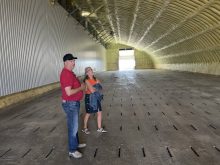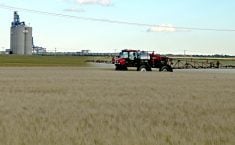OUTLOOK, Sask. – The status quo is not good enough, agreed the parents, teachers and taxpayers present for the first meeting on restructuring Saskatchewan’s public schools.
The province’s school divisions have not changed substantially from the 119 formed more than 50 years ago, said Don Sangster, a regional director of the education department. He told the meeting Sask-atchewan has more school divisions than all provinces except Ontario and Quebec. But since 1971, rural depopulation has been affecting enrolments.
There are a third fewer students in rural Saskatchewan than 25 years ago. In the past year, rural public schools lost 1,700 students, equivalent to one large school closing.
Read Also

New coal mine proposal met with old concerns
A smaller version of the previously rejected Grassy Mountain coal mine project in Crowsnest Pass is back on the table, and the Livingstone Landowners Group continues to voice concerns about the environmental risks.
It was the closure of two schools in her division, at Conquest and Macrorie, that brought one parent to the meeting. Jean Harrington, of Glenside, said she and her friend have discussed division restructuring for months.
“How come we have to give up good education to maintain mediocre stuff,” asked the mother of three students. As for the four options outlined by the education department’s public paper, she said she would favor them all as long as they came in proper stages.
The four options range from no change, to division amalgamation, to a partnership approach with business and other community agencies, to regional learning authorities that group all learning agencies under one board. Sangster said “the government does not have a particular plan waiting. The intent is to listen to the feedback (from the 60 meetings planned) and go from there.”
Peter Popowich of Outlook, who attended the May 27 meeting that started five months of public consultations, said, “I don’t think anyone said the status quo. Everyone said move on.”
Feedback from the 40 people sorted into small groups was broken down into four themes. Under the area of what services to offer students, the adults said they want rural schools to offer the same courses as urban areas; that computers and access to libraries are important; that classes should be smaller so teachers can spend more time with individual students; and that schools should help students with work placements and life skills, not just academic subjects.
While some thought elected school boards may enhance parent/ community involvement, others felt local elections have low turnouts and appointed people might be better because “some elected officials have a personal agenda.”
Some proposed the governing board or council be mainly parents but others wanted a good cross section of the community that included taxpayers who had no children, plus teachers and students.
“We’ve got to make schools more positive and caring. Right now most parents come to school only because their kid is in trouble,” said Ron Chapdelaine, the regional co-ordinator of curriculum, in summing up one of the parent’s concerns.
Most agreed there should be closer links with libraries, and connections with business for student work placements, with cultural organizations and with social services and health districts. A tax credit for businesses that sponsor a student work assignment or donate to school fund raisers was suggested.
Under the final theme of leadership and direction, groups reported they wanted to have a say in setting the future for school divisions, but they also wanted government to carry out the job after hearing feedback.
Harrington urged the government to move quickly once it finished with the consultations because under the past few years of voluntary amalgamations, only four were tried. Without quick action she said “my kids will have failed school because they’ll have to get up at 2 a.m. to catch the school bus to Saskatoon.”
Added Sue Robertson, “if we don’t make an attempt to continue to change, we’ll be dead in the water.”
Sangster said the intent is to have whatever process is selected in place for the school board elections to be held across the province in October 1997.
















